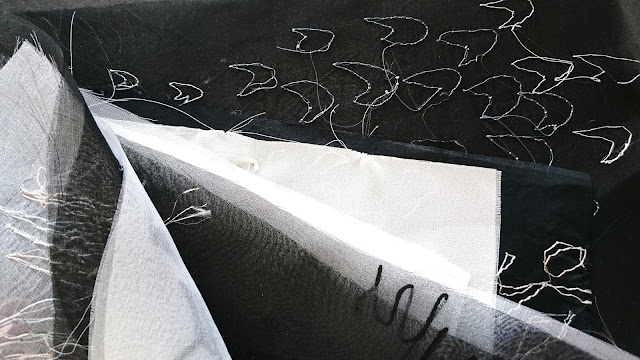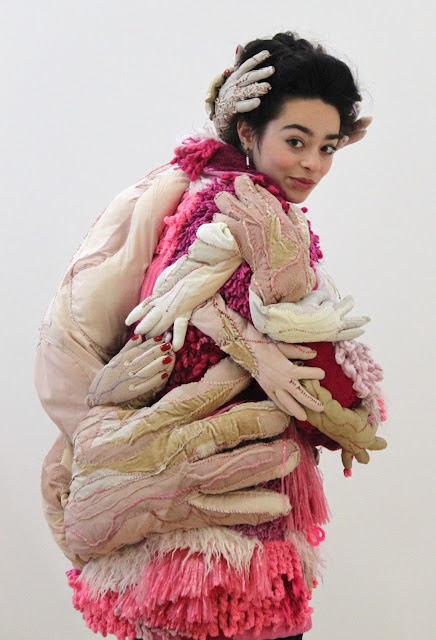"This is a process driven project analysing how natural dying techniques, such as: rust, fruits, seeds and plants, react differently to a variety of fabrics. I experimented by pushing the boundaries of these techniques while learning to control and replicate shape and pattern. The fabrics I have chosen to use all have their own individual qualities. By using different materials this demonstrates how diverse the techniques change depending on the medium. My collection will aim to show how versatile the processes can be and how they react towards different fabrics. These fabric panels are all natural and are designed to be used as insulation's for commercial interiors market." Shiona McMahon
Tuesday, 31 May 2016
Shiona McMahon
Monday, 30 May 2016
Rachael Flynn
"Focusing on local bird life, I decided to use a reserved colour palate, working largely in monochrome and adding hints of subtle colour to highlight and celebrate the beauty of our British bird life. My visual research has been hugely focused around the idea of fragility; both mirroring the fragility of nature itself and that of the delicate structure of feathers. This inspired my use of silk and silk organza fabrics as these are light and soft. Additionally, I found that the organza added an element of translucence to my work that mirrored the sheer aesthetic of feathers. I also wanted my work to contrast in design; paralleling a literal drawing style which portrays a celebration of the beauty of the British bird life, with a mixed media and illustrative approach that characterises the life and energy of these birds in movement." Rachael FlynnRachael focused her attention on birds, her sketchbooks were a rich and delightful exploration of this subject. In her finished designs Rachael chose to use a limited monochrome palette and built up the textile design using silk organza and stitch in technique almost like Japanese sashiko or boro. The finished fabrics mascaraed a simplicity that is beguilingly complex.
Sunday, 29 May 2016
Som Kerdsiri
Brightly patterned, loose flowing, draped garments by Som Kerdsiri contrasting with tight red patent thigh length boots
Saturday, 28 May 2016
Alice Firman
"I am everyday inspired by people’s thoughts and different ways of processing emotions and situations as well as my own. My interests lie in aiming to understanding how the human mind and our emotions work and translating that into fashion through garments.
Choosing what you wear is a choice that comes from within; therefore fashion should celebrate not only diversity ‘on the outside’ but also diversity within ‘minds’.
Your way of thinking, of feeling, of processing emotions is what makes you yourself, unique and different from everyone else around you.
What’s inside your mind?
What are you feeling?
Think differently,
Feel differently, it’s a strength!" Alice Firman
Alice Firman's graduate collection from The ECA Fashion Show was inspired by Peter Lindbergh's film 'The Heist' and utilised techniques of male tailoring to create a strong independent look that also appears feminine. Alice used lace which she deconstructed into individual flowers before reconstructing it with hand stitching and combining it with hand printed, laser cut petals. This creates a combination of dark structure with more organic feminine form breaking through.
Friday, 27 May 2016
Morag Taylor
This is the work of Textile design graduate Morag Taylor you can catch her work as part of the Duncan and Jordanstone College of Art Degree Show at Dundee until Friday the 29th May.
"I have been exploring form, movement and colour and how they relate to each other through manipulating materials in different ways. Form. Discovering how the form that the fabric takes can be altered through cutting and layering techniques. Movement. The forms come to life through the way that they are held and stretched evolving from flat two-dimensional pieces into new structures. Colour. Inspired by the surface and reflections on water, dying fabric in subtle gradients and solid colours plays an important role in transforming the pieces. The fabrics are layered to have different colours on each side so that when moved the three-dimensional aspect is emphasised. I have made a collection of fabric samples to be developed into wearable pieces." Morag TaylorMorag Taylor has been exploring slashed fabrics creating form from sheets of fabric through repeated cuts contorting the fabric into a honeycomb or lace-like form. Her work has been inspired by the undulation of water and light refracted on its surface.
Thursday, 26 May 2016
Deborah Cook
Deborah Cook is a costumier for our favourite tiny actors and actresses, the costumes for stop motion animations including Box Trolls, Fantastic Mr Fox, Coraline and The Corpse Bride.
This is a fascinating film sharing some of her working processes from the costume conception, through colour and fabric choices, pattern cutting, animation testing and the final fitting. Deborah studied sculpture at Central St Martins working on sculpted textile installations. Then set up her own studio and started working for theatre and film before moving into costumes for animation.
"The fabric in animation is very subtle and finer and has to pass as ‘real’ within its own smaller world. People-scale fabrics look very chunky and thick and impede and mask the tiny movements and gestures the puppet characters make as well as looking very unreal and colossal on their tiny bodies. Their movements need to be reproduced akin to people and made possible within the flexibility of their costumes. To create a believable environment in miniature, the fabrics need to fit in too." Deborah Cook
Klara Landin Larsson I
Klara Landin Larsson is currently in the second year of Performance Costume at ECA and this was her fantastic frog costume. I am looking forward to seeing what she creates over the next few years as she progresses through her degree.
"The frog costume is made as a padded body suit. That means, there's one layer of skin tight lycra onto which I have sewn layer upon layer of wadding and foam, (I'd estimate I used about 5 meters of wadding in total). This whole process was very much more like sculpting than tailoring since there was no set way of doing it. The top layer is one layer of disperse dyed mesh on top of another layer of lycra, which was draped on the final wadding shape and then sewn together." Klara Landin Larsson
Klara's model relaxing between shows.
Wednesday, 25 May 2016
Claudia Johns II
"Witches could be anywhere at any time and have the aim to rid the world of children and their characteristics; fuss, mess and other fun things creating a more ordered, clinical and controlled world. Taking inspiration from constructivist art and Advance Style Blogs an all female army has been formed to recreate the traditional witch stereotype. A minimalist symbol of recognition has been developed for a contemporary camouflage representing the witches aim of mass control and capture creating a netlike skeletal world map."
Other traits are the angular and pointed elements used within the costume design acting as strange limb-like appendages that can be used mid-performance when trying to camouflage themselves and a strong, bold colour pallet with tactile layers to lure the children in." Claudia Johns
Tuesday, 24 May 2016
Laura Rose Moran-Morris I
This is 'Oberon' created by Laura Rose Moran-Morris, an ECA Performance Costume graduate, brought to life by her model Finlay at the ECA Fashion Show last week. This costume was a psychedelic extravaganza of orange and pink faux fur with incorporated tassels, a pompom crown, and super swirly satin trousers.
"Illusion and reality blur in this playful, multisensory adaptation of the classic story. Influences for this costume were drawn from late 60's psychedelia, for this celebration of midsummer madness. A visual and textural dreamscape explodes onto stage to create a comedic musical extravaganza." Laura Rose Moran-Morris
Monday, 23 May 2016
Claudia Johns I
The corset is a soft luxurious satin representing the vulnerability of Esther and the restrictions of women at this time creating an objectified appearance. The laser cut leather decorative breast piece and cage represent the slashing of her body in order to find what she feels is ‘wrong’ with her and acts as the metaphorical bell jar that builds up around her throughout the production.
Sunday, 22 May 2016
Aurélie Fontan
"My garment emerged from the Diversity Network project that The Edinburgh College of Art initiates every year in collaboration with "All walks beyond the catwalk". The purpose was to consider my practice as a designer applying my designs across a range of silhouettes / people/ morphology."Aurélie chose to tackle, within a panel of diverse people, the theme of masculinity in fashion, which she perceived to be pulled to two extremes; either very feminine (transgender wave) or very masculine (stereotypes conveyed through media) .
"I was really interested in Sam, he is an art student who equally dresses with womenswear and menswear. I researched gender in fashion and media and specifically gender fluidity."Aurélie through research came up with the concept of Sam not having to have the dilemma of choosing between masculinity and femininity but being able to accommodate both in one garment. A garment that celebrated a more sensitive masculinity and that is able to empower men who feel their body or personality
is not represented by contemporary society.
"As part of this project I had to include a 3D typography on the garment as a statement to reinforce my concept - the word Alpha is suggesting another word -"male"- to convey a strong contrast that is stated as an ironical criticism of society's expectations about masculinity." Aurélie Fontan
Saturday, 21 May 2016
Patti Amat I
Friday, 20 May 2016
Rosie Whiting I
Paying homage to Caryl Churchill's play Top Girls, a play in which the audience dine alongside Louise Bourgeois, Nina Simone, Emmeline Pankhurst, Mata Hari, Marie Curie, Amelia Earhart, Conchita Cintron, Martha Graham and host Marlene. Performance Costume graduate; Rosie Whiting has created 'Louise and Nina' two wonderfully complex rich costumes full of texture and technique. The 'Louise Bourgeois' costume (above) is resplendent with many hands all seeming to caress and protect the wearer especially the headpiece where hands gently cup the hair. The sassy 'Nina Simone' costume (below) has a bold knit bodice and fishnet crochet overlay of satin trousers.
Subscribe to:
Comments (Atom)



















































